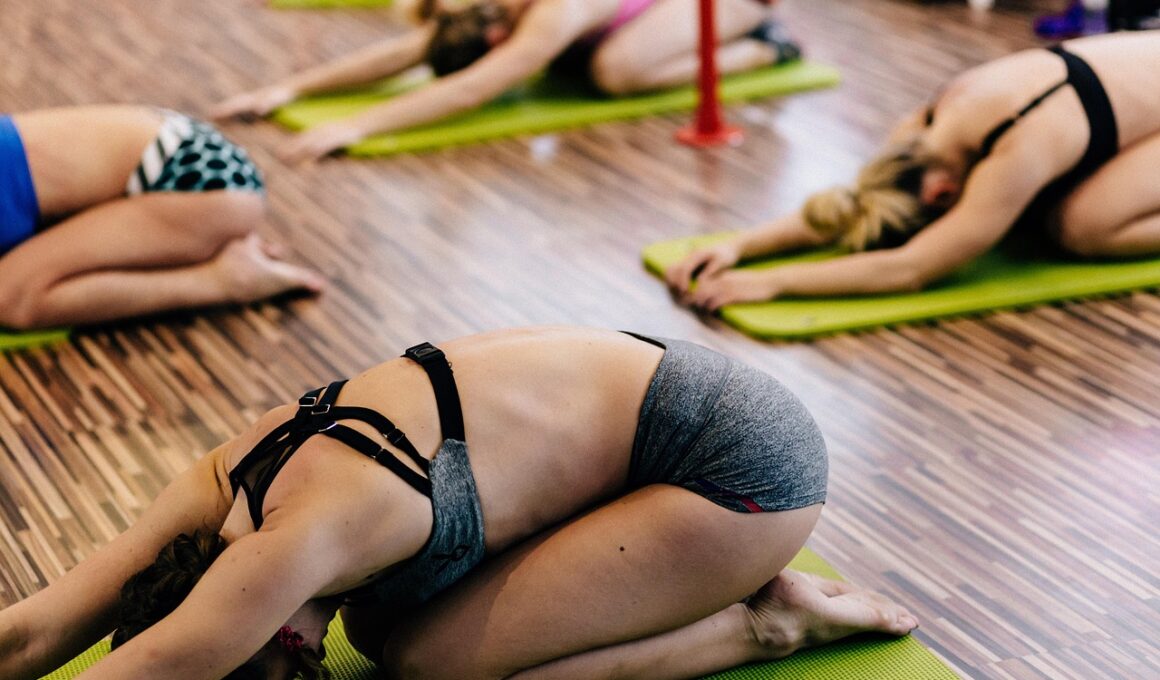The Role of Breath in Holding Yoga Poses
Breath is central to the practice of yoga, serving not only as a means of sustaining life but also as a vital tool for enhancing the effectiveness of yoga poses. In yoga, the control of breath is termed ‘Pranayama,’ which means regulation of the life force. Pranayama assists in grounding practitioners, allowing for deeper focus and connection to the body. When you hold a pose, your breathing directly impacts your stability and endurance. You can cultivate a deeper understanding of your physical limits and emotional responses by matching your breath with movements. Additionally, long, deep breaths help release tension in the muscles, enhancing flexibility. While practicing challenging poses, breath becomes particularly significant. When one feels fatigue or discomfort, mindful breathing can help maintain composure, facilitating greater balance in mind and body. To fully experience the benefits of breath in poses, consider using techniques like inhaling deeply through the nose and exhaling fully through the mouth. This simple act of breath awareness can transform your yoga practice. Integrating breath into your practice enhances the physical aspects but also allows for a more profound meditative experience.
Maintaining focus through breath can lead to better posture alignment in yoga. When you inhale deeply, it naturally expands the rib cage and allows for optimal oxygen flow. This oxygen is critical for sustaining muscle activity during the poses. Moreover, proper alignment helps prevent injuries commonly associated with improper positioning. When practicing poses such as Downward Dog or Warrior, pay attention to your breath. Inhaling as you lengthen your spine and exhaling as you push deeper into the stretch can create a better foundation for your practice. As you progress, try using your breath to initiate movements, syncing it with every transition between postures. This sync helps create a rhythm, allowing your body and mind to work together harmoniously, which is essential for holding poses effectively. Your breath should feel natural, not forced, developing gradually as your practice deepens. Over time, as the connection between breath and movement strengthens, you will experience increased stamina and adaptability in challenging poses. This dynamic interaction forms the core of a holistic yoga practice, paving the way for both physical and spiritual growth.
Deepening Your Practice
Breath can be your anchor in maintaining focus during yoga sessions. In difficult poses, breath provides the necessary motivation to persist, pushing through discomfort and challenging your limits. As breath regulates the body’s response to exertion, it becomes essential to practice mindfulness around breathing techniques. Implementing a technique like Ujjayi breath, where you create a soft sound at the back of your throat, can prevent hyperventilation and stabilize your breathing during strenuous poses. This increases oxygen intake and develops endurance. Moreover, Ujjayi breath assists in keeping the mind present, reducing distractions both internally and externally. This concentrated state enhances the overall quality of your practice. During long holds, constantly monitor your breath, ensuring it remains steady and deep. If shortness of breath occurs, ease deeper into the pose at your discretion. Thus, one can explore a higher realm of consciousness by understanding the relationship between breath and physical presence. As yoga encompasses the holistic being, integrating breath allows for a transformative experience both physically and emotionally. Incorporating these techniques is the key to unlocking deeper levels of practice and achieving true serenity.
The breath’s role extends beyond mere physical exertion; it deeply connects the mind and body. By bringing awareness to the breath during practice, you’re actively cultivating self-awareness, not just physically but also emotionally. This heightened awareness allows practitioners to confront emotions that may arise while holding a challenging pose. When one feels uncomfortable or anxious, focusing on taking calm, controlled breaths can be incredibly beneficial. This creates space for emotional exploration and enhances one’s emotional resilience. In cases of anxiety or fear, returning to the breath can restore a sense of calm and groundedness. Incorporating breath meditation at the beginning or end of your practice can also aid the transition into deeper, more mindful states. This practice could involve simply observing the breath flow in and out, promoting acceptance of the present moment. Gradually, this self-care practice encourages a nonjudgmental acceptance of your abilities or limitations while practicing yoga. Through understanding this deeper interconnectedness of breath and emotion, a practitioner can cultivate lasting mindfulness both on and off the mat, enriching their overall wellbeing and enriching daily experiences.
Conclusion: Embracing Breath in Yoga
To embrace the importance of breath within yoga actively is to enrich your entire practice. Breathing gives you the tools to navigate through the complexities of physical postures and mental challenges, creating a supportive environment for holistic growth. Your journey in yoga thrives on the mindful integration of conscious breathing techniques, fostering an enriching experience. Mindful breathing can uncover layers of awareness that contribute to emotional balance, physical strength, and mental focus. Practicing poses with appropriate breathing techniques can lead to enhanced cardiovascular performance, increased flexibility, and improved circulation. With each inhale and exhale, embodying breath promotes relaxation and reduces tension. As you learn to hold poses while remaining aware of your breath, you also begin to cope with stress and anxiety with greater ease, enhancing your quality of life beyond the mat. Encouragement to observe the profound impact of your breath encourages personal growth and transformation. Establishing an ongoing relationship with your breath is paramount for deepening your yoga practice and fostering a harmonious existence both on and off the mat. This relationship could be one of the most beautiful gifts you impart to yourself.
In conclusion, the role of breath in holding yoga poses is vital to understanding the nuances of yoga practice. Breath acts as a bridge between mind and body, enhancing physical endurance and offering emotional clarity. By embracing and practicing proper breathing techniques, you can achieve a deeper connection to each pose. This connection allows for personal exploration while also cultivating a better sense of balance. The effectiveness of your practice increases significantly when breath becomes a central focus. When a practitioner aligns their breath with each movement, they unlock a transformation that adds depth to their experience. The shifts in awareness that come from mindful breathing can lead to improved mindfulness not just during practice but also across everyday activities. Efforts to improve breathing habits can lead to further benefits in overall health and well-being. Thus, embarking on your yoga journey, consider breathing an essential aspect of your growth and development. Make a commitment to connect with your breath; in doing so, you embrace the holistic nature of yoga that fosters both physical and mental harmony. This journey will enrich not just your practice but also your quality of existence.
As you progress in yoga, the understanding of breath should evolve. Join workshops, read literature, or participate in discussions with experienced yogis. Learning different breathing techniques can enhance your practice and help you discover new dimensions of yourself. Resources like yoga classes and online platforms offer various methods to incorporate breathwork into physical practice. Exploring these options can lead to greater self-discovery, offering insights into your limitations and strengths. Moreover, sharing this knowledge with peers enhances your learning experience, as teaching others reinforces your understanding. Practicing with a community fosters accountability and encourages deeper exploration of breath in yoga. Over time, keeping a journal of your experiences can help track changes in your practice, particularly regarding breath awareness and its impact on your performance. By documenting unique discoveries, you’ll be able to recognize growth both personally and in your yoga journey. Embrace the challenge and allow your breath to be your guide; it can lead to profound moments of clarity and awareness. The relationship between breath and yoga poses is a lifelong journey, filled with opportunities for learning and shared understanding.
Through the integration of breath in yoga, one can cultivate a harmonious balance between the physical, mental, and emotional aspects of life. This balance enriches your life experience and helps you develop resilience against everyday stressors. Each yoga session can become a sanctuary, allowing you to recharge and renew as you embrace breath awareness while holding poses. Building a consistent practice around breath facilitates not only improved strength and flexibility but also greater peace of mind. Creating said practice involves regular reflection on how breath influences each aspect of your being. Allowing yourself time to explore your breath as you experience various poses means you’ll grow more attuned with your body. This ongoing exploration can be incredibly rewarding, offering insights beyond simply physical gains. It helps on your journey toward overall wellness and spiritual growth. With dedication and commitment, you can effectively utilize breath as a tool that empowers you, creating a ripple effect in every facet of your life. Ultimately, breath is not merely a function of life; it becomes a bridge to higher self-awareness and enriched personal experiences in every yoga session.


